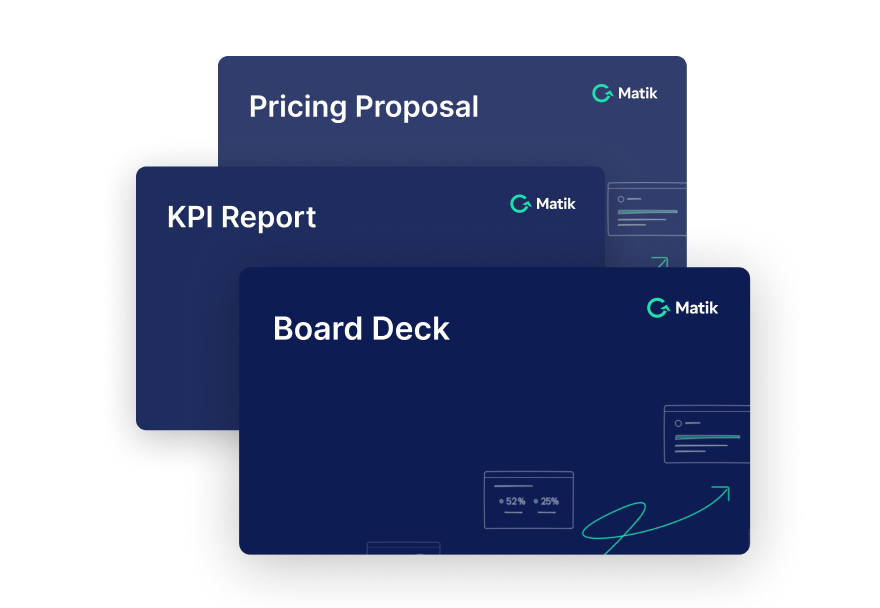Join Our Newsletter
Welcome to the latest post in our Content on Matik series. In this series, we will be taking a look at some of the innovative ways Matik customers have used data-driven storytelling to create compelling content, and build better relationships with their customers.
Meet the Pitch Deck.
What is a Pitch Deck?
A Pitch Deck is a several slide presentation that you share with a potential customer during an initial demo or conversation about your product. This presentation should focus on the pain you’re solving for and how you can solve it for this particular customer (in other words, it should be tailored to their specific needs).
Remember that a pitch deck should be pain-centric and prospect-centric, not product-centric. What that means is you should focus your deck on your customer’s specific pain and goals, instead of taking them through an obviously generic, slide-by-slide monologue on your product.
What is the value of a Pitch Deck?
A pitch deck is likely the first piece of collateral that your prospect will receive from you, so it’s incredibly important.
A good pitch deck opens up a larger conversation with your prospect that helps you learn more about why they’ve approached you in the first place, what their process looks like today, and maybe even the details of their buying process.
A poorly done pitch deck, on the other hand, can leave the prospect disengaged and with a bad taste in their mouth. When this happens, it often doesn’t matter if your tool is better than the others they are evaluating. If they have a bad demo and pitch deck experience, they’re going to be less invested in re-engaging and pursuing a partnership with you after the call.
What is in a Pitch Deck?
A pitch deck contains five sections - Qualitative Pain, Quantitative Pain, Social Proof, Product Overview, and Next Steps.
Kick off the deck with this first section - Qualitative Pain. In this slide, provide customer quotes, anecdotal examples, and images that illustrate the pain you’re looking to solve for. For example, you could collect a customer quote that says something like, “Before Product X, my team was spending hours per month making presentations, instead of having strategic value conversations with our customers.”
The next section, Quantitative Pain, is where you can dig into the data behind those qualitative examples above. Here, for example, you could include a table that shows that most of your customers, before using your product, were spending 4-6 hours a week per employee to do a task that you automated. Take these hours, multiply them by the size of a standard team (let’s say 15 people), and then multiply that again by average salary cost per hour to get an estimation of how that time-loss translates, for many companies, to lost dollars on their team.
Once you’ve effectively illustrated the pain with these slides, and brought your customer into the conversation to discuss how their own pain looks similar or different, pull up the third slide - Social Proof. Here is where you can list out all of the logos of your referenceable customers, to show your prospect the types of industry-leaders you are currently working with. These logos should be easily recognizable names and/or companies that are competitors in your prospect’s industry.
After this, dig into your product overview. Here is where you should give a high level explanation, in 1-2 slides, of how your product works to solve the pain outlined in slides 1 and 2. From here, you can jump back and forth into the product to also show your customer how this works in a live demo instance.
After the product demo, bring your prospect back to the deck to review Next Steps. This slide should be partially filled out with your suggestions for next steps, but should also be a live document that you invite your customer to participate in. Based on the conversations you had during this call, what next steps are relevant or realistic? Outline them here and get your customer’s consent for the proposed steps or timeline. Best case scenario, use this time to also get that next meeting on the books.
If you follow these steps, you will be much more likely to run a successful demo call that keeps your customer engaged, informs them about your product, makes them feel heard, and encourages them to buy in to the next steps in your sales process.
In Short
Pitch Decks are the first piece of collateral your potential customer will see during an initial demo of your product, and are a tool for structuring your call with the goal of setting up the next step in the sales process.
---
See Matik in Action—Request a Demo















